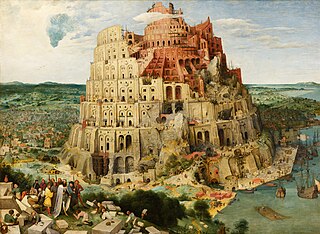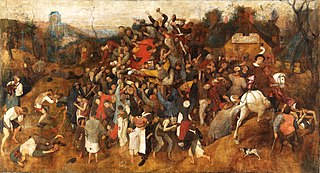
Pieter Bruegelthe Elder was among the most significant artists of Dutch and Flemish Renaissance painting, a painter and printmaker, known for his landscapes and peasant scenes ; he was a pioneer in presenting both types of subject as large paintings.

The Kunsthistorisches Museum Wien is an art museum in Vienna, Austria. Housed in its festive palatial building on the Vienna Ring Road, it is crowned with an octagonal dome. The term Kunsthistorisches Museum applies to both the institution and the main building. It is the largest art museum in the country and one of the most important museums worldwide.

The Harvesters is an oil painting on wood completed by Pieter Bruegel the Elder in 1565. It depicts the harvest time set in a landscape, in the months of July and August or late summer. Nicolaes Jonghelinck, a merchant banker and art collector from Antwerp, commissioned this painting as part of a cycle of six paintings depicting various seasonal transitions during the year.

The Tower of Babel was the subject of three paintings by Dutch and Flemish Renaissance painter Pieter Bruegel the Elder. The first, a miniature painted on ivory, was painted in 1552–1553 while Bruegel was in Rome, and is now lost. The two surviving works are oil paintings on wood panels, sometimes distinguished by the prefix "Great" and "Little" and by their present location: Kunsthistorisches Museum Wien in Vienna and the latter in the Museum Boijmans Van Beuningen in Rotterdam. The Tower of Babel in Vienna is dated 1563, while the version is Rotterdam is undated but widely believed to have been painted sometime after.

The Peasant Wedding is a 1567 genre painting by the Dutch and Flemish Renaissance painter and printmaker Pieter Bruegel the Elder, one of his many depicting peasant life. It is now in the Kunsthistorisches Museum, Vienna. Pieter Bruegel the Elder enjoyed painting peasants and different aspects of their lives in so many of his paintings that he has been called Peasant-Bruegel, but he was an intellectual, and many of his paintings have a symbolic meaning as well as a moral aspect.
Events from the year 1565 in art.

The Hunters in the Snow, also known as The Return of the Hunters, is a 1565 oil-on-wood painting by Pieter Bruegel the Elder. The Northern Renaissance work is one of a series of works, five of which still survive, that depict different times of the year. The painting is in the collection of the Kunsthistorisches Museum in Vienna, Austria. This scene is set in the depths of winter during December/January.

The Return of the Herd is a panel painting in oils by Pieter Bruegel the Elder, made in 1565. It is one in a series of six works that depict different seasons. The painting is now in the Kunsthistorisches Museum, Vienna, Austria. The autumnal colors of the landscape and the bare trees connect this particular painting to October/November.

The Wine of Saint Martin's Day is the largest painting by Pieter Bruegel the Elder. It is currently held in the Museo del Prado, Madrid, where it was identified as a Bruegel original in 2010. Like much of Bruegel's work it depicts peasant life, in this case a festival known as St. Martin's Day, which involves drinking the first wine of the season.

Storm at Sea is an oil painting on panel attributed the Netherlandish Renaissance artist Pieter Bruegel the Elder, painted c. 1569. It is held in the Kunsthistorisches Museum, in Vienna.

The Peasant Dance is an oil-on-panel by the Netherlandish Renaissance artist Pieter Bruegel the Elder, painted in circa 1567. It was looted by Napoleon Bonaparte and brought to Paris in 1808, being returned in 1815. In is now in the Kunsthistorisches Museum in Vienna.

Conversion of Paul is an oil-on-panel painting by the Netherlandish Renaissance artist Pieter Bruegel the Elder, painted in 1567. It is now in the Kunsthistorisches Museum in Vienna.

The Procession to Calvary is an oil-on-panel by the Netherlandish Renaissance artist Pieter Bruegel the Elder of Christ carrying the Cross set in a large landscape, painted in 1564. It is in the Kunsthistorisches Museum in Vienna.

The Peasant and the Nest Robber is an oil-on-panel painting by the Netherlandish Renaissance artist Pieter Bruegel the Elder, painted in 1568. It is in the Kunsthistorisches Museum in Vienna.

Children's Games is an oil-on-panel by Flemish Renaissance artist Pieter Bruegel the Elder, painted in 1560. It is now in the Kunsthistorisches Museum in Vienna. The entire composition is full of children playing a wide variety of games. Over 90 different games that were played by children at the time have been identified.

The Census at Bethlehem is an oil-on-panel painting by the Flemish Renaissance artist Pieter Bruegel the Elder, painted in 1566. It is signed and measures about 1155 × 1645 mm. It is now in the Oldmasters Museum in Brussels, which acquired it in 1902.

Several oil-on-oak-panel versions of The Massacre of the Innocents were painted by 16th-century Netherlandish painters Pieter Bruegel the Elder and his son Pieter Brueghel the Younger. The work translates the Biblical account of the Massacre of the Innocents into a winter scene in the Southern Netherlands in the prelude to the Dutch Revolt against Spanish rule, also known as the Eighty Years' War.

Nicolaes Jonghelinck (1517–1570) was a merchant banker and art collector from Antwerp. He is best known for his collection of paintings by Pieter Bruegel the Elder and Frans Floris. His brother was the sculptor Jacques Jonghelinck.

The Adoration of the Magi in the Snow is a painting in oils on oak panel of 1563, by Pieter Bruegel the Elder, now in the Oskar Reinhart Collection Am Römerholz in Winterthur, Switzerland. With two Italian exceptions, it is thought to be the first depiction of falling snow in a Western painting, the snowflakes boldly shown by dots of white across the whole scene, added when the work was otherwise completed.

Winter Landscape with a Bird Trap, also known as The Bird Trap, is a panel painting in oils by the Flemish painter Pieter Bruegel the Elder, from 1565, now in the Oldmasters Museum in Brussels. It shows a village scene where people skate on a frozen river, while on the right among trees and bushes, birds gather around a bird trap. It is signed and dated at the lower right: "BRVEGEL / M.D.LXV’1". There are more early copies of this than any other painting by Pieter Bruegel the Elder, many by his much younger son Pieter Brueghel the Younger, or other members of the Brueghel family dynasty and workshop. The art historian Klaus Ertz documented 127 copies in his comprehensive monograph on the artist's son in 2000.































